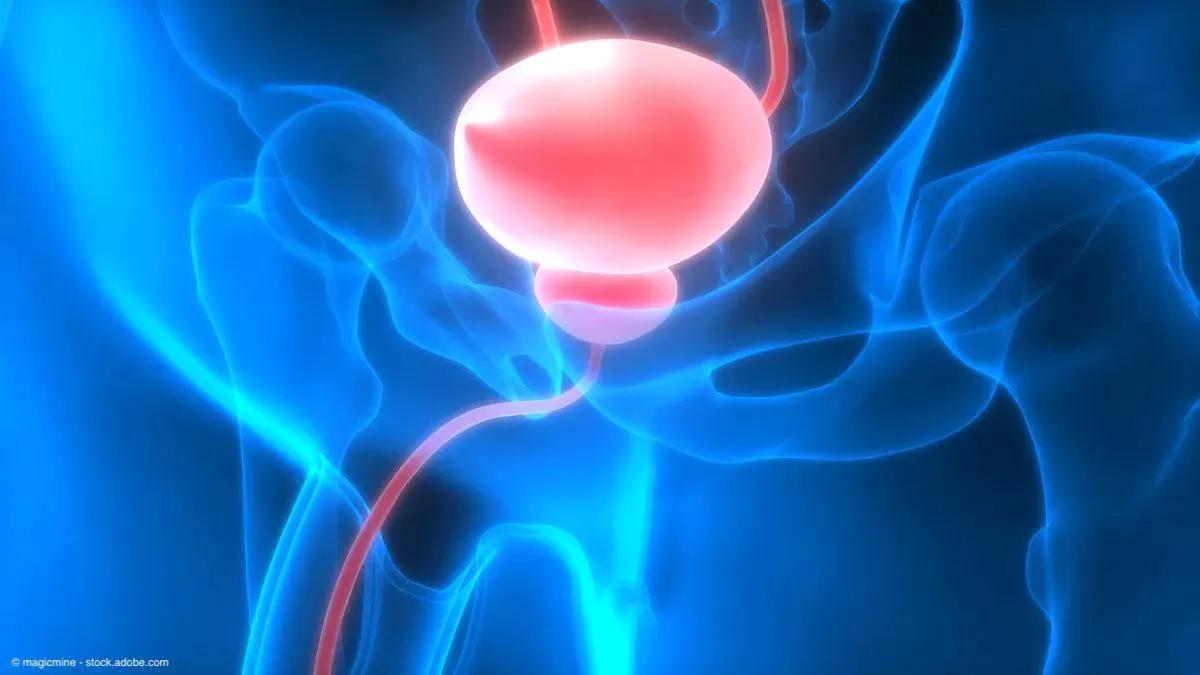News
Article
UGN-102 reaches nearly 80% complete response rate in low-grade intermediate-risk NMIBC
Author(s):
The mitomycin-containing reverse thermal gel UGN-102 achieved an approximately 80% complete response rate as primary chemoablative therapy in patients with low-grade intermediate-risk non–muscle-invasive bladder cancer (NMIBC), according to findings from the phase 3 ENVISION trial presented at the 2023 Society of Urologic Oncology Annual Meeting.1
“Additional data evaluating duration of response and other secondary end points from the ENVISION trial are anticipated in 2024,” said Sandip Prasad, MD.

At 3 months’ follow-up, the complete response rate was 79.2% (95% CI, 73.5-84.1) with UGN-102. In the remaining patients, 14.6% had residual disease, 2.5% progressed to high-grade disease, 1.7% had an indeterminate response, and 2.1% did not have data.
“If approved by the FDA, UGN-102 would be the first non-surgical treatment option for patients with low-grade intermediate-risk NMIBC, with the potential to be a paradigm shift in the way in which we treat and evaluate these patients going forward,” said presenting author Sandip Prasad, MD, Morristown Medical Center/Atlantic Health System and Garden State Urology, Morristown, NJ.
The open label single-arm ENVISION trial included 240 patients with low-grade intermediate-risk NMIBC. The study defined this disease status as having 1 or 2 of these characteristics:
- Single tumor larger than 3 cm
- Multiple tumors
- Early or frequent recurrence, defined as having at least 1 occurrence of low-grade NMIBC within 12 months of current diagnosis
The median patient age was 70.0 years (range, 30-92), 61% of patients were male, 39% were female, and 99% were White. Ninety-six percent of patients had prior transurethral resection of bladder tumor (TURBT). Overall, 91% of patients had 2 or fewer previous low-grade NMIBC episodes.
Patients received primary chemoablative therapy with UGN-102 as 6 once-weekly intravesical instillations administered using a traditional urethral catheter. “This is primary therapy—patients did not undergo TURBT,” explained Prasad.
Nearly all patients (95%) received the full 6 instillations.
The primary end point was the rate of complete response 3 months after the initial instillation. Secondary outcome measures include duration and durability of response, as well as disease-free survival.
The safety population included all 240 patients. Nearly all treatment-emergent adverse events (TEAEs) were mild or moderate. TEAEs occurring in at least 5% of patients included dysuria (17.9% mild; 3.8% moderate), (hematuria 6.3% mild; 2.1% moderate), pollakiuria (5.4% mild; 0.8% moderate), urinary tract infection (1.7% mild; 4.2% moderate), and fatigue (3.8% mild; 1.7% moderate). One patient had severe dysuria.
“Two patients experienced treatment related serious AEs consisting of urethral stenosis and urinary retention. The 2 deaths on trial—pneumonia and cardiac arrest—were deemed unrelated to study treatment,” said Prasad.
“Additional data evaluating duration of response and other secondary end points from the ENVISION trial are anticipated in 2024,” Prasad concluded.
ATLAS trial
UGN-102 previously demonstrated efficacy in the phase 3 ATLAS trial. In the study. UGN-102 with or without TURBT was shown to improve outcomes vs TURBT alone in patients with low-grade intermediate-risk NMIBC.2
Compared with TURBT alone, treating patients with primary, non-surgical chemoablation with UGN-102 with or without subsequent TURBT led to a 55% reduction in the risk of recurrence, progression, or death (event-free survival [EFS]). The EFS rate at 15 months was 72% for patients who received UGN-102 with or without TURBT vs 50% for patients treated with TURBT alone (HR, 0.45).
Additionally, at the first disease assessment 3 months following initiation of treatment, the tumor-free complete response rate was 65% (92 of 142 patients ) for those receiving UGN-102 with or without TURBT, compared with 64% (89 of 140 patients) for those receiving TURBT alone.
References
1. Prasad S, Mladenov B, Shishkov D, et al. Primary chemoablation for recurrent low grade intermediate risk (LG IR) NMIBC: the ENVISION trial. Presented at: 2023 Society of Urologic Oncology Annual Meeting. November 28 – December 1, 2023; Washington, DC. LBA 3389.
2. Prasad SM, Huang WC, Shore ND, et al. Treatment of Low-Grade Intermediate-Risk Nonmuscle-Invasive Bladder Cancer with UGN-102 ± Transurethral Resection of Bladder Tumor (TURBT) Compared to TURBT Monotherapy: A Randomized, Controlled, Phase 3 Trial (ATLAS) [published online ahead of print August 7, 2023]. J Urol. doi: 10.1097/JU.0000000000003645

















